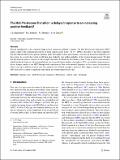The Mid-Pleistocene Transition: a delayed response to an increasing positive feedback?
Author(s)
Shackleton, J. D.; Follows, M. J.; Thomas, P. J.; Omta, A. W.
Download382_2022_Article_6544.pdf (2.360Mb)
Publisher with Creative Commons License
Publisher with Creative Commons License
Creative Commons Attribution
Terms of use
Metadata
Show full item recordAbstract
Abstract
Glacial–interglacial cycles constitute large natural variations in Earth’s climate. The Mid-Pleistocene Transition (MPT) marks a shift of the dominant periodicity of these climate cycles from
$$\sim 40$$
∼
40
to
$$\sim 100$$
∼
100
kyr. Recently, it has been suggested that this shift resulted from a gradual increase in the internal period (or equivalently, a decrease in the natural frequency) of the system. As a result, the system would then have locked to ever higher multiples of the external forcing period. We find that the internal period is sensitive to the strength of positive feedbacks in the climate system. Using a carbon cycle model in which feedbacks between calcifier populations and ocean alkalinity mediate atmospheric CO
$$_2,$$
2
,
we simulate stepwise periodicity changes similar to the MPT through such a mechanism. Due to the internal dynamics of the system, the periodicity shift occurs up to millions of years after the change in the feedback strength is imposed. This suggests that the cause for the MPT may have occurred a significant time before the observed periodicity shift.
Date issued
2022-11-04Department
Massachusetts Institute of Technology. Department of Earth, Atmospheric, and Planetary SciencesPublisher
Springer Berlin Heidelberg
Citation
Shackleton, J. D., Follows, M. J., Thomas, P. J. and Omta, A. W. 2022. "The Mid-Pleistocene Transition: a delayed response to an increasing positive feedback?."
Version: Final published version